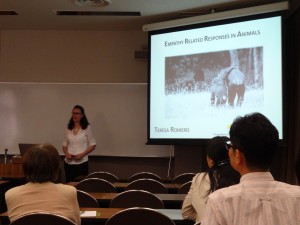
講演者: Teresa Romero 先生 (東京大学)
日 時: 2016年6月29日(水) 15:10~16:40 (延長する場合があります)
場 所: 関西学院大学上ケ原キャンパス F号館306号教室
タイトル:Empathy-related responses in animals
要旨:
Empathy is usually defined as the ability to share and understand the emotions and cognitions of others, and it is considered a core component of sociality. Not only does it enable individuals to coordinate inner states and cooperate towards joint goals, but it allows partners to establish and maintain successful relationships. Although there are several models explaining this phenomenon in humans, all of them agree that different components of empathy can be considered and measured separately. Based on this assumption, animal empathy is best regarded as a multilayered phenomenon, built around motor mirroring and shared neural representations at basal levels, that develops into more advanced cognitive perspective-taking in large-brained species. Accumulating evidence from animal research reveals that different levels or facets of the empathic capacity may be present through much of the evolutionary history of vertebrates, with basic forms, such as emotional contagion, being found in most of the existing social species. Here, I will present examples of expressions of empathy in animals that closely resemble those of our own species. I will show work reveling that in chimpanzees (Pan troglodytes), bystanders at a fight go out of their way to provide calming contact to distressed victims, which in children is interpreted as a sign of sympathetic concern. I will also give examples of less complex expressions of empathy, such as unconscious mimicry in domestic dogs (Canis lupus familiaris) and wolves (Canis lupus lupus). Finally, I will show that oxytocin, a hypothalamic neuropeptide that plays an important role in various reproductive effects in mammals, may modulate prosocial and empathic responding in both human and nonhuman animals. Collectively, these and other animal research strongly suggest that empathy-related responding in humans have homologous not only in our closest primate relatives, but also in other mammals.
参加に際し,文学部・総合心理科学,文学研究科・総合心理科学専攻の方は事前連絡は必要ありません。
それ以外の方は,お手数ですが、場所・時間変更などがあった場合の連絡のため真田原行(msanada[at]kwansei.ac.jp)までご一報いただけると幸いです(必須ではありません)。
報告:
In this seminar, Dr. Teresa Romero reviewed her ethological and neuroscience studies indicating that empathic capacities and neural mechanisms are shared not only with other primates but also with other mammalian species.
First, she introduced behavioral evidence showing that mammals have homologous social and empathic abilities; inequity aversion and contagious yawning. Inequity aversion is defined as negative reactions to unequal outcomes, with extreme cases in which individuals prefer getting nothing to getting a reward that is not fair in comparison to their neighbor’s. Dr. Romero reported that, when using the same paradigm that in primate studies, dogs showed the same response. This finding indicates that although dog is a species phylogenetically far from primates, they also have the ability to understand social fairness.
Contagious yawning occurs when yawning propagates among individuals. This has been considered as a synchronized response to other’s behavior, reflecting basic empathic abilities. Previous animal research has observed that contagious yawning occurs in several primate species as well as in dogs. Dr. Romero found that dogs showed this response more frequently when intimate other (e.g. their owner) yawned than when non-intimate one did. Furthermore, this was also true for the case of wolves. These findings indicated two things; 1) contagious yawning related to animal’s social capacity indeed; 2) the underlying mechanism of contagious yawning is is phylogenetically ancient, and it is currently present in a wide range of species.
She then introduced her work on consolation behavior in chimpanzees. Consolation, which is considered a sympathetic response aimed at comforting others in distress, has been observed widely in humans, but only in few mammalian species. Although human studies on consolation and sympathetic concern have investigated the relational, developmental and individual aspects of the behavior, previous animal research has only focused on the relational level. In her research, Dr. Romero analyzed all three levels of analysis providing novel insights to socio-cognitive and emotional competence in animals. For example, like in humans consolation behavior occurred more frequently among close social partners, such as kin and friends, than among non kin or non-affiliated associates. Her analysis also revealed that chimpanzees showed consistent individual differences in their tendency to offer consolation to others, and that these differences were stable across sequential age-classes. Further, she also found a significant positive association between an individual’s consolation tendency and its social integration, a sign of general social competence.
Finally, she presented her studies about the role of oxytocin in modulating social bonds in dogs. Her research showed that inhaled oxytocin promoted dog’s social bonding with their owner, and that the interchange of positive social behavior triggered the release of oxytocin in dogs. These results suggest the existence of an “oxytocin-mediated positive feedback loop”, which might be an important neural substrate for forming and maintaining close social bonds in mammals.
In conclusion, many mammalian species, and not just primates, show responses in social situations that are similar to humans’ empathic responses, which suggests that homologous empathic reactions are present in many animals. Furthermore, the mechanisms underlying these social responses might be also widely shared among mammals. Empathy is a psychological construct which is important in human society. However, animal research tells us that empathy is not a unitary system, but one that has several components, and that some of these components are shared by many mammalian species. Thus, comparing their social responses and the mechanisms underlying these responses helps to elucidate the evolution of human empathy.
During and after her talk, audience asked her many questions, and active debate was held. This was a very good opportunity to think about what empathy is, and the importance of comparative studies to investigate it.
参加者23名
文責:真田原行

